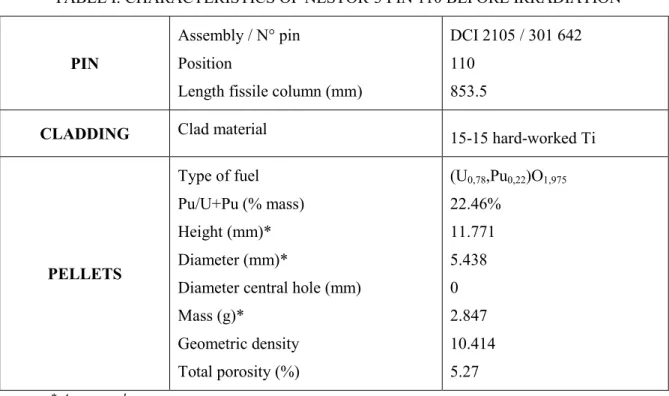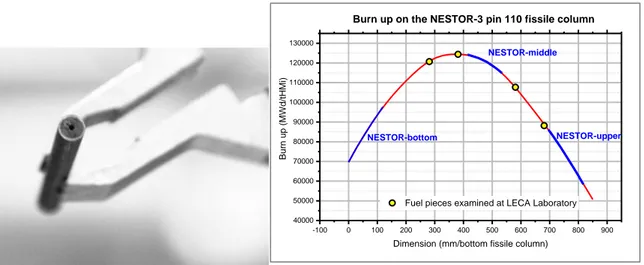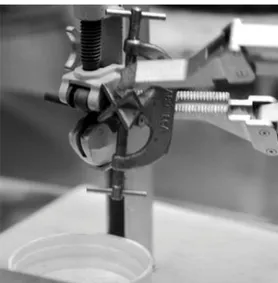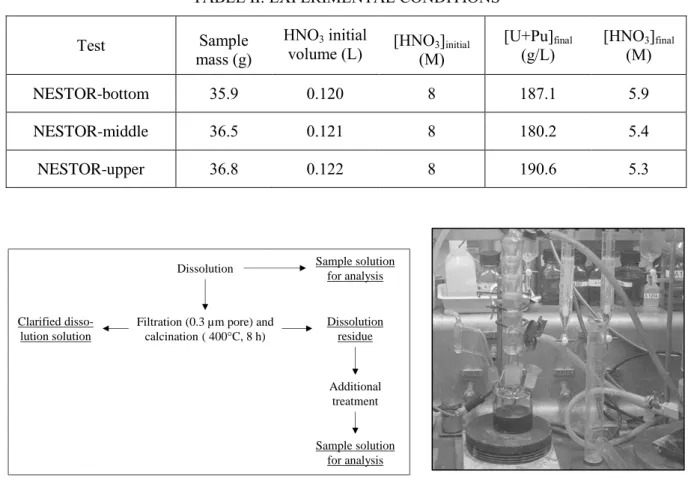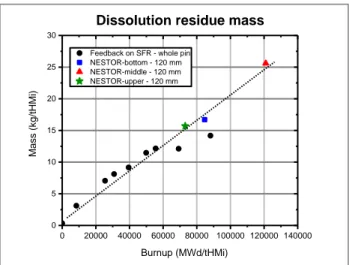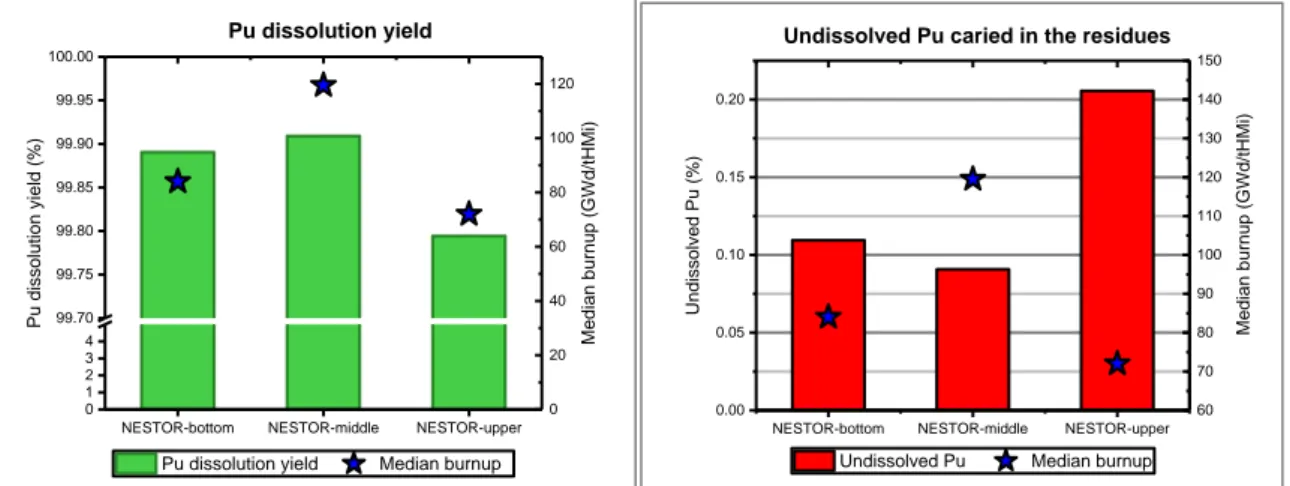HAL Id: hal-02419630
https://hal.archives-ouvertes.fr/hal-02419630
Submitted on 19 Dec 2019HAL is a multi-disciplinary open access archive for the deposit and dissemination of sci-entific research documents, whether they are pub-lished or not. The documents may come from teaching and research institutions in France or abroad, or from public or private research centers.
L’archive ouverte pluridisciplinaire HAL, est destinée au dépôt et à la diffusion de documents scientifiques de niveau recherche, publiés ou non, émanant des établissements d’enseignement et de recherche français ou étrangers, des laboratoires publics ou privés.
mox fuel in boiling nitric acid (the phenix nestor-3 tests)
N. Reynier-Tronche, E. Buravand, L. Huyghe, E. Esbelin, X.
Machuron-Mandard, S. Grandjean
To cite this version:
N. Reynier-Tronche, E. Buravand, L. Huyghe, E. Esbelin, X. Machuron-Mandard, et al.. A compre-hensive study of the dissolution of spent sfr mox fuel in boiling nitric acid (the phenix nestor-3 tests). International Conference on Fast Reactors and Related Fuel Cycles Next Generation Nuclear Systems for Sustainable Development (FR17), Jun 2017, Yekaterinburg, Russia. �hal-02419630�
A comprehensive study of the dissolution of spent SFR MOX fuel in boiling
nitric acid (the PHENIX NESTOR-3 tests)
N. Reynier-Tronche, E. Buravand, L. Huyghe, E. Esbelin, X. Machuron-Mandard, S. Grandjean
CEA, Nuclear Energy Division, Reasearch Department on Mining and Fuel Recycling Processes,
F-30207 Bagnols sur Cèze, France
E-mail contact of main author: nathalie.reynier-tronche@cea.fr
Abstract. Dissolution experiments undertaken on irradiated fuel pins from sodium-cooled fast reactors (SFRs) date back to the 1980s at the French Commissariat à l’Energie Atomique et aux Energies Alternatives (CEA). They have been carried out in different workshops and laboratories, using different experimental conditions. New dissolution studies were initiated two years ago on an irradiated pin from a PHENIX NESTOR-3 assembly, and involved separate sections of a single fissile pin in order to better understand its dissolution behavior. Three dissolution experiments were thus run at the CEA-Marcoule on 30 mm long pieces of irradiated materials, using three distinct 120 mm sheared sections of a (U,Pu)O2 fissile NESTOR-3 pin (bottom, middle i.e. full-flux zone, upper). The dissolution experiments were carried out in boiling nitric acid (8 M) for 6 hours to produce a feed solution concentrated to about 180 g/L of Heavy Metals (HM, U+Pu).
The masses of dissolution residues were measured, and the Pu dissolution yield and undissolved Pu rate were calculated for each test, then for each fissile column zone.
Key Words: dissolution, fast reactor, plutonium, residues
1. Introduction
Dissolution experiments undertaken on irradiated fuel pins from sodium-cooled fast reactors (SFRs) date back to the 1980s at the French Commissariat à l’Energie Atomique et aux Energies Alternatives (CEA). They have been carried out in different workshops and laboratories, using different experimental conditions. In order to regain then extend the knowledge on SFR MOX treatment and recycling for 4th Generation systems, new dissolution studies were initiated two years ago on an irradiated pin from a PHENIX NESTOR-3 assembly (initial Pu content 22.5%, burnup 12.9 at%) that had been characterized by destructive and non-destructive Post Irradiation Examinations (PIEs) at the CEA-Cadarache.
As previous dissolution experiments were always carried out on a whole irradiated pin (including the lower axial column), the dissolution behaviour observed was always averaged for a given pin and therefore sometimes difficult to interpret and to correlate with another fuel. It was therefore decided to carry out innovative dissolution studies on perfectly known separate sections of a single fissile pin to better understand its dissolution behaviour.
2. Experimental 2.1.Materials
The NESTOR-3 assembly n° “DCI 2105 zone 1” was fabricated in ATPu plant at CEA Cadarache in 1984, with the COCA fuel manufacturing process. Its characteristics before irradiation are given in TABLE I.
TABLE I: CHARACTERISTICS OF NESTOR-3 PIN 110 BEFORE IRRADIATION
PIN
Assembly / N° pin Position
Length fissile column (mm)
DCI 2105 / 301 642 110
853.5
CLADDING Clad material 15-15 hard-worked Ti
PELLETS
Type of fuel Pu/U+Pu (% mass) Height (mm)* Diameter (mm)*
Diameter central hole (mm) Mass (g)* Geometric density Total porosity (%) (U0,78,Pu0,22)O1,975 22.46% 11.771 5.438 0 2.847 10.414 5.27 * Average values
The NESTOR-3 assembly was irradiated at different locations in the PHENIX core 1 for 758 Equivalent Full Power Days (EFPD) between 24/07/1984 and 19/07/1987 for a maximum burnup of 13.4 at%, i.e. 126.2 GWd/tHMi. The nominal cladding temperature reached 650 °C in the second half of the irradiation period.
Pin gamma-scanning spectrometry carried out in the LECA facility with results processed with the GERMINAL code enabled calculation of the burnup for all sections of the fissile column [1]. Erreur ! Source du renvoi introuvable. shows the burnup with each fuel portion to dissolve in Atalante (blue lines) and the small portions studied in the LECA facility (destructive examinations) [2].
The maximum burnup of pin 110 as estimated by the GERMINAL code was 12.9 ± 0.1 at%, corresponding to 124.4 GWd/tHMi.
FIG. 1. Fuel piece of fissile column before shearing (NESTOR/01)
FIG. 2. Burnup of fissile column, 110 NESTOR-3 pin
2.2.Dissolution test
Three dissolution experiments were carried out in the C11/C12 shielded cells of the Atalante facility (FIG. 3).
FIG. 3. C11/C12 shielded cells in Atalante facility
Each dissolution involved 30 mm long pieces of irradiated materials (FIG. 5) after shearing three distinct 120 mm sections of a (U,Pu)O2 fissile NESTOR-3 pin (bottom, middle i.e. full-flux zone, upper) with a tube cutter (FIG. 4).
-100 0 100 200 300 400 500 600 700 800 900 40000 50000 60000 70000 80000 90000 100000 110000 120000 130000
Fuel pieces examined at LECA Laboratory
NESTOR-upper NESTOR-middle
NESTOR-bottom
Burn up on the NESTOR-3 pin 110 fissile column
Bu rn u p ( M Wd /t H M i)
FIG. 4. Fuel cutting with tube cutter FIG. 5. Fuel pieces before dissolution
Dissolutions were conducted in boiling nitric acid (8 M) for 6 hours to produce a feed solution concentrated to about 180 g/L of U+Pu. The experimental conditions for this study are detailed in TABLE II, while FIG. 6 shows the sample separation procedure conducted in dissolution tests. A 0.5 L flat bottom glass flask placed on a hotplate and equipped with a cooling condenser was used, as shown in FIG. 7.
TABLE II: EXPERIMENTAL CONDITIONS
Test Sample
mass (g)
HNO3 initial
volume (L) [HNO(M) 3]initial [U+Pu](g/L) final
[HNO3]final
(M)
NESTOR-bottom 35.9 0.120 8 187.1 5.9
NESTOR-middle 36.5 0.121 8 180.2 5.4
NESTOR-upper 36.8 0.122 8 190.6 5.3
FIG. 6 : Schematic flow sheet of sample separations to determine chemical composition
FIG. 7. Dissolution experimental setup
A specified amount of fuel (sheared to 30 mm long) and nitric acid were poured into the flask at the shielded hot cell temperature (30°C), and the mixture was heated up to and maintained at boiling temperature (109°C) for 6h. The time to reach 109°C was about 30 min.
The reaction progression was monitored by counting the 85Kr released from the fuel matrices,
by gamma-ray counting in the process extraction system. The reaction had finished when the
count number of released 85Kr dropped to and stayed at the level of the background count, i.e.
within less than 3 h in each test.
2.3.Measurement of dissolver solution composition and the dissolution residue
After the test had finished and the dissolver solution had been cooled to room temperature, the solid components dispersed in the dissolver solution, such as hulls, were collected by suction
filtration on a Millipore® filter with 0.3-µm pore diameter (FIG. 8). The flask, hulls and filters
were rinsed with clean dilute nitric acid to eliminate contamination. Two to three filters were used for each test.
Dissolution
Filtration (0.3 µm pore) and calcination ( 400 C, 8 h) Clarified disso-lution sodisso-lution Dissolution residue Sample solution for analysis Additional treatment Sample solution for analysis
FIG. 8. Dissolution residue appearance on the Millipore® filter
Concentrations of U, Pu, Fe, Ni, Cr and FPs in the dissolution solution were measured using K-EDGE densitometer for U and Pu, gamma spectrometry for FP nuclides and Inductively Coupled Plasma-Atomic Emission Spectroscopy (ICP-AES) for other elements of interest. U and Pu isotopies were measured by Thermal Ionization Mass Spectrometry (TIMS). Cladding corrosion in nitric acid and the release of Fe, Ni and Cr in dissolution solution are not discussed in this paper.
Filters with rinsed dissolution residue were calcinated for 8 hours at 400°C and then weighed. Dissolution residues were dissolved (method not described in this paper) [3]. Solutions were also analyzed using the same method as for the dissolution solution to assess each test.
3. Results and discussion
3.1. Mass of dissolution residues
TABLE III shows the residue dissolution mass for each test in mg and calculated in relation to the mass of initial heavy metal (kg/tHMi). The middle zone with high burnup had the greatest mass.
The results are compared with previous results obtained for whole SFR pins in FIG. 9, depending on the maximum burnup for entire pin or local burnup for the NESTOR pieces. The results confirm a characteristic observed on entire fuel pins: the higher the burnup, the greater the residue mass.
TABLE III : MASS OF CALCINATED DISSOLUTION RESIDUE
Test Local BU (GWD/tHMi) Residue mass mg kg/tHMi NESTOR-bottom 70-98 410 ± 13 16.7 ± 1.7 NESTOR- middle 124-115 638 ± 13 25.6 ± 2.6 NESTOR-upper 86-58 398 ± 8 15.7 ± 1.6
FIG. 9. Mass of calcinated dissolution residue for different SFR MOX fuels
The fission product Nd is a good burnup indicator, and was analyzed in each solution. It is interesting to combine the neodymium content in the dissolution solution and the residue mass: the mass follows the trend for the mass of neodymium. These results are consistent because the higher the burnup, the greater the amount of fission products (FP), the latter being known to be the main constituents of the residues. They are essentially precipitates of metallic FPs or oxides, as was demonstrated during examinations of the solid [2].
FIG. 10. Residue masses and Nd in the dissolution solutions (NESTOR-3)
These results are in line with feedback on SFR fuel treatment, although the full-flux zone value is high. This can be explained by the fact that the feedback has given average values for a whole irradiated pin (including the lower axial column).
0 20000 40000 60000 80000 100000 120000 140000 0 5 10 15 20 25 30 Ma ss (kg /tHMi)
Dissolution residue mass Feedback on SFR - whole pin
NESTOR-bottom - 120 mm NESTOR-middle - 120 mm NESTOR-upper - 120 mm
Burnup (MWd/tHMi)
NESTOR-bottom NESTOR-middle NESTOR-upper 0 5 10 15 20 25 30
Residue mass and Nd in the dissolution solution
Residu e ( kg/t HMi) Residue Nd 0.00 0.05 0.10 0.15 0.20 0.25 0.30 Nd ( g)
3.2. Pu dissolution yield and undissolved Pu rate
“Pu dissolution yield” (in %) was determined for each test using the following formula:
It is customary to use the term “undissolved Pu rate” value (in %), as is done in MOX pellet fabrication tests. This is determined with the following formula, which in fact represents the amount of solid Pu carried in the residues:
The undissolved Pu carried in the dissolution residues of PHENIX fuel irradiated at burnup ≤100,000MWd/tox did not exceed 0.1% [4]. This good solubility is generally attributed to the COCA fuel manufacturing process used for the fabrication of the PHENIX fuels [5].
TABLE IV presents the results obtained with NESTOR-3 pin 110 (scheme given FIG. 11).
TABLE IV: PU DISSOLUTION YIELD
Test Local BU (GWd/tHMi) Pu/(U+Pu) in dissolution solution (%) Pu dissolution yield (%) Undissolved Pu rate (%) Undissolved Pu* (g/tHMi) NESTOR-bottom 70-98 21.2 99.891 0.109 197 NESTOR- middle 124-115 21.2 99.909 0.091 163 NESTOR -upper 86-58 20.5 99.794 0.206 370
* Undissolved Pu extrapolated mass (g/tHMi) = (100% - Pu dissolution yield) * Pu after irradiation (g/tHMi) calculated
with evolution code (= 180 034.63 g/tHMi 19/01/2015)
The dissolution by zone reveals heterogeneity along the fissile column: the more irradiated the fuel, the more soluble the Pu is. This had never been previously revealed on a single pin.
FIG. 11. Pu dissolution yield or undissolved Pu and median burnup of fuel examined in each test
NESTOR-bottom NESTOR-middle NESTOR-upper 0 1 2 3 4 99.70 99.75 99.80 99.85 99.90 99.95 100.00 Pu dissolution yield Pu disso lution yield (%)
Pu dissolution yield Median burnup
0 20 40 60 80 100 120 Me dian bu rn up (G Wd/tHMi)
NESTOR-bottom NESTOR-middle NESTOR-upper 0.00
0.05 0.10 0.15 0.20
Undissolved Pu caried in the residues
Undisso
lved
Pu (%)
Undissolved Pu Median burnup
60 70 80 90 100 110 120 130 140 150 Me dian bu rn up (G Wd/tHMi)
The strong linear power density (whose profile is close to the burnup, Erreur ! Source du renvoi introuvable.) is a predominant factor in the decrease in Pu carried in the residues from the most irradiated zone, by erasing the initial heterogeneities Pu in the oxide. NESTOR-upper corresponds to the NESTOR-upper extremity of the pin, where the burnup is the lowest (decreasing from 86 to 58 GWd/tHMi) and it is the zone where the quantity of Pu in the residues is the highest (0.2%).
The results showed that the undissolved Pu rate is between 0.09% for the full-flux zone portion and 0.21% for the upper zone, the least irradiated, in accordance with feedback on SFR fuel treatment for which the undissolved Pu rate value was on average close to 0.1%. 4. Conclusion
Three dissolution experiments were carried out on 30 mm long pieces of irradiated materials after shearing three distinct 120 mm sections of a (U,Pu)O2 fissile NESTOR-3 pin (bottom, middle i.e. full-flux zone, and upper). Dissolution experiments were carried out in boiling nitric acid (8 M) for 6 hours to produce a feed solution concentrated to about 180 g/L of HM. The results showed that the undissolved Pu rate is between 0.09% for the full-flux zone portion and 0.21% for the upper zone, the least irradiated. These results are in accordance with the feedback on SFR fuel treatment, i.e. an undissolved Pu rate value on average close to 0.1%.
The mass of calcined residues varied greatly as a function of the dissolved zone: about 16.7 kg/tHMi pour the bottom and upper extremities, and 25.6 kg/tHMi for the full-flux zone. These results are also in line with feedback on SFR fuel treatment, although the full-flux zone value is higher. This can be explained by the fact that feedback gives average values for a whole irradiated pin (including the lower axial column). As the residue mass increases with the burnup, it is higher for the central full-flux zone than at the extremities, and lower for the upper zone which is less irradiated than the bottom zone of the fissile column.
Dissolution by zone has revealed the heterogeneity along the fissile column: the more irradiated the fuel, the more soluble the Pu is, but also the higher the residue mass because of the greater quantity of fission products. This is of interest, and had never been previously reported.
5. References
[1] J. Melis J., L. Roche, J. Piron, J. Truffert, J., GERMINAL - A computer code for predicting fuel pin
behavior, Journal of Nuclear Materials, 1992,p.303-307
[2] J. Lamontagne, Nestor-3 experiment: destructive post irradiation examinations on pin 110, FP7-Fission-2013 - Combination of Collaborative project (CP) and Coordination and Support Actions (CSA) - Grant agreement no: 605172, European Commission - ESNII plus – Deliverable D732 – revision 0 issued on 30/06/2015
[3] E. Buravand, N. Reynier-Tronche, B. Catanese, P. Huot, M. Crozet, E. Esbelin, X. Machuron-Mandard, S. Grandjean, First assessment of a digestion method applied to recovery of plutonium from
calcinated residues after dissolving spent SFR MOX fuel in nitric acid, International Conference on
[4] JJ. Fabre, F. Rouches, FBR Fuel Design, Manufacture and Reprocessing, International Conference on fast reactors and related fuel cycles, FR’91
[5] M. Viala, M. Tarnero, M. Bougeois, French Development Program on Fuel Cycle, International Conference on fast reactors and related fuel Cycles, FR’91
